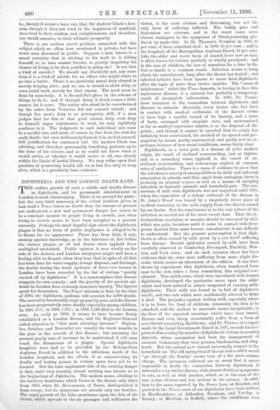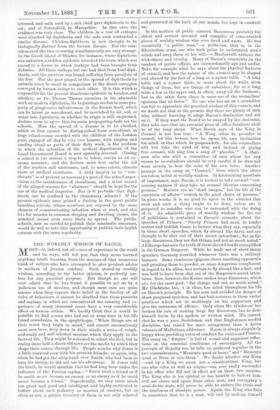DIPHTHERIA AND THE LONDON DEATH-RATE. T HE sudden growth of such
a subtle and deadly disease as diphtheria, and its permanent establishment in London, is most discouraging. There is no ground for panic ; but the very brief summary of the actual position given in last week's Times leaves no doubt that, for reasons at present not understood, a new and permanent danger has arisen to be a constant menace to people living in crowds, just when living in crowds seems to have been accepted as a present necessity. Perhaps the most hopeful sign about the diphtheria plague is that no form of public negligence is alleged to be to blame for its appearance. There has been little, if any, sinning against knowledge, as in the tolerance of dirt before the cholera plague, or of bad drains when typhoid fever multiplied unchecked. Public opinion is now wholly on the side of the doctors, and London ratepayers might well have a feeling akin to despair when they hear that in spite of all that has been done for water-supply, sewage disposal, and drainage, the deaths daring the worst epidemic of fever ever known in London have been exceeded by the list of victims "quietly carried off by diphtheria." It is anommouplace that disease suggests its own remedy ; and the gravity of the present epi- demic in London does certainly stimulate inquiry. The figures speak for themselves. The Times' estimate is that, by the close of 1893, the diphtheria epidemic will account for 3,000 deaths. The mortality has steadily crept up year by year, and the disease has been progressively more deadly, especially among children. In 1887, 953 ; in 1888, 1,311; in 1889, 1,588 died in the London area. As early as 1888, it seems to have become firmly established as a London disease, and the Registrar-General called attention to "this most alarming increase." Septem- ber, October, and November are usually the worst months in the year in the records of this disease ; but assuming the present yearly rate of increase to be maintained, it will soon reach the dimensions of a plague. Special diphtheria hospitals have had to be provided by the Metropolitan Asylums Board in addition to the infectious wards of the London hospitals, and the effects of so concentrating its deadly and lasting poison in certain spots have yet to be learned. Not the least unpleasant side of the existing danger is that, until very recently, almost nothing was known as to the beginnings of diphtheria. The modern name, alluding to the leathery membrane which forms in the throat, only dates from 1856, when Dr. Bretonneau, of Tours, distinguished it from croup; but its symptoms are already only too familiar. The rapid growth of the false membrane upon the skin of the throat, which spreads to the air passages and suffocates the victim, is the most obvious and distressing, but not the only form of suffering inflicted. The bodily pain and depression are extreme, and in the worst cases seem almost analogous to the symptoms of blood-poisoning pro- duced by snake-bite. In St. Thomas's Hospital in 1889, 46 per cent. of those admitted died ; in 1890, 42 per cent. ; and in the hospitals of the Metropolitan Asylums Board, 42 per cent. Like the older and worst form of scarlet fever now so rare, it often leaves its victims partially or wholly paralysed ; and in the case of children, the loss of sensation for a time in the feet or hands is a common result. Infection seems to hang about the convalescent, long after the throat has healed ; and. infected articles have been known to cause fatal diphtheria after the lapse of more than twelve months. The "sense of helplessness" which the Times laments, in having to face this mysterious disease, is a natural, but probably a temporary, result of incomplete information. In 1886, Dr. Turner drew attention to the connection between diphtheria and diseases in animals. Recently, every doctor who has been in contact with marked outbreaks of the disease seems to have kept a careful record of its history, and a mass of facts, arranged with singular care, and systematised so far as medical experience admits, is at the disposal of the public ; and though it cannot be asserted that its origin has definitely been ascertained, the method of its spread and pro- pagation by means partly unsuspected, and partly new to ex- perience because of new social conditions, seems fairly clear.
Diphtheria, as a town peat, is a disease of quite modern origin, the result of civilised overcrowding, just as typhus, and in a secondary sense, typhoid, is the result of un- civilised overcrowding, and semi-savage neglect of common rules of sanitation. There is a mass of evidence to show that the infection is conveyed among children by daily and enforced association in schools, and that, apart from contagion, there is probably an original source, as well as a means of carrying infection, in domestic animals and household pets. The con- nection of milk with diphtheria was not suspected until 1878, when the connection of a violent outbreak of the disease in St. John's Wood was traced by a singularly clever piece of medical reasoning to the milk-supply from two dairies owned by one dealer. But the conclusions as to the real nature of the infection so carried are of far more recent date. That the in- fection from scarlatina or measles should be conveyed by milk which was quite harmless until it came in contact with fever germs derived from some human convalescent, is not difficult to understand. But the present presumption is that diph- theria is often caused by milk given by a cow itself suffering from disease. Recent epidemics caused by milk have been carefully observed at Camberley, Devonport, Finchley, Hen- don, and York town and on each occasion there has been evidence that the cows were suffering from some slight die- order which causes an ulceration of the udders. It has been shown by experiment that diphtheria, when tranferred from man to the cow, takes a form resembling this original cow- ailment. Two miloh-cows, which were inoculated with human diphtheria, developed the particular sores upon the udder which had been noticed in others suspected of causing milk. diphtheria. Their milk was found to be full of diphtheria bacilli, and two cats which were accidentally allowed to drink it died. The prejudice against boiling milk, especially where it is to form the food of children, commonly the first to be attacked, and the earliest to succumb, seems inexplicable, in the face of the repeated warnings which have been issued. Horses, and even sheep, occasionally suffer from a form of sore-throat resembling diphtheria; and Dr. Turner, in a report made to the Local Government Board in 1887, records his sur- prise at discovering the number of diphtheria victims in country districts, whose occupation had been the management of animals. Commonly they were grooms, blacksmiths, and shep- herds. But the animal now almost universally suspect is the household eat. The old saying that if the cat had a cold it would "go through the family," seems tree of a far more serious charge. The instances collected are so many that it seems impossible to doubt the connection between diphtheria in man and a very similar disease, with almost identical symptoms, in cats, as well as with another, which, as in the case of the cow, is less obvious and less serious in the animal. In addi- tion to the cases reported by Dr. Bruce Low, at Hendon, and quoted in the Times, cases of cat-diphtheria have been noticed in Hertfordshire; at Aldershot, Farnham, and Yateley, in Surrey ; at Moulton, in Suffolk, where the conditions were reversed, and milk used by a sick child gave diphtheria to the cat; and at Petersfield, in Hampshire. In this case, the evidence was very clear. The children in a row of cottages were attacked by diphtheria, and the cats soon contracted a similar disease. Chicken-diphtheria is now thought to be biologically distinct from the human disease. But the coin- cidencesof the two occurring simultaneously are very strange. In the Greek island of Skiatos, for instance, where diphtheria was unknown, a sudden epidemic attacked the town, which was traced to a house to which turkeys had been brought from Salonica. All these turkeys but one had died from fowl-diph- theria, and the survivor was found suffering from paralysis of the feet. But the part played in the spread of diphtheria by animals must be small in comparison to the direct contagion conveyed by human beings to each other. It is this which is responsible for the present disastrous epidemic in London, and whether, as Dr. Thorne Thorne surmises in his admirable work on modern diphtheria, its beginnings are due to some pro- perty of progressive infectiveness in the disease itself, which oan lie latent as sore-throat, and be nourished by air, soil, or water into diphtheria, or whether its origin is still unguessed, doctors seem to agree that its main propagating-beds are the schools. How the spread of a disease is to .be checked, which at first cannot be distinguished from sore-throat, in huge school-rooms crowded with the children of the London poor, engaged all day in viva vote lessons, with singing and reading aloud as parts of their daily work, is the problem to which the attention of the medical department of the Local Government Board is now specially directed. Closing a school is too serious a step to be taken, except as an ex- treme measure ; and the doctors must first enlist the aid of the masters and mistresses, and, to some extent, educate them as medical assistants. A daily inquiry as to " sore- throats " is at present as necessary a part of the school super- vision as the maintenance of cleanliness, and a strict record of the alleged reasons for " absences " should be kept for the ose of the medical inspector. But is it probable that diph- theria can be confined to the elementary schools ? If the present epidemic once gained a footing in the great public boarding.schools, whose members are exposed to the same Chances of communicating infection when at work, and also live for months in common sleeping and dwelling rooms, the mischief seems even more likely to spread. The public- echools, now so careful to publish their scholastic successes, would do well to take this opportunity to publish their health returns with the same regularity.







































 Previous page
Previous page